This post is the second in a series of three. This part discusses the second leg of our trip to Egypt, our journey to Egypt’s Southern Gems including Aswan and Abu Simbel. Many of Egypt’s most notable and important historic sites are in the southern part of the country (paradoxically known as “Upper Egypt”), around Luxor and Aswan. Our tour focused around Cairo, Aswan, and Luxor. You’ve read about our time in Cairo, and next time I’ll focus on Luxor.
Vuong found a 9-day tour on Left Lane Sports during COVID and got a screaming deal. He paid $1000 each for this all-inclusive, small group tour which included Cairo and the pyramids, Aswan, Abu Simbel, Luxor, the Valley of the Kings, and a few other stops. Unfortunately, Left Lane Sports no longer sells travel packages; however, the outfitter was actually “Encounters Travel,” and the tour was called “Nubian Adventure.” You can book it now for only $1600 per person, which is still a great deal for everything we received! Read about our time in Cairo here.
Better still, you can book a custom, bespoke tour with our tour guide, Aboudy! He is funny, engaging, kind, and so knowledgeable. He is a certified Egyptologist and truly made us feel like we were being shown around Egypt by a friend. Contact me and I will put you directly in touch with him! Are you interested in Ancient Aliens? The mystical, spiritual aspects of Egypt? Meditation retreats? He is your guy!
Aboudy recently joined his sister’s travel agency. Based out of Luxor and specializing in spiritual tours, let Go Luxor show you Egypt! He also highly recommends Pink Lotus Tours, a boutique travel agency offering custom tours.
Aswan
The Overnight Train
When I left off last, we were leaving Cairo. We took an overnight train to Aswan. You could fly from Cairo to Aswan, and that is recommended by many tour organizers. I thought the train was great for many reasons. We didn’t have to waste valuable daylight hours traveling- driving, getting to the airport early, waiting, etc. Boarding the train was quick and easy, and we slept for most of the 12-hour ride. It was less expensive than many other methods of transport, coming in around $100 for a 2-person sleeper compartment (if we had paid out of pocket, ours was included in the tour). AND it saves the cost of a night in a hotel. Combining transportation with accommodation is great!
Not to mention that taking an overnight train is an experience. We had taken an overnight train before, from Hanoi to Sa Pa, Vietnam. We enjoyed it, so we thought we would do it again. We’d do it again if it made sense for our schedule, but not just for the experience. Book your train ticket here. If you leave from Rameses station, you have lots of food options. Grab a Hawawshi to go… these Egyptian meat pockets are to die for.
The room consisted of a top bunk bed with chairs underneath that fold down into a second bed, and a sink. We were served dry chicken nuggets and yucky rice, so we were happy to have picked up snacks for the trip. Be sure to bring snacks! The beds were fine, and the rhythm of the moving train helped soothe us to sleep. Breakfast consisted of bread, bread, more bread, cake, and coffee.
I’m going to leave off the part about how I actually spent half of the night in the bathroom of our carriage. Something got me and it was miserable.
If you want more details and a nice review of the overnight train, check out this article.
Our Hotel
Our hotel, the Tolip Aswan, was super luxe and a welcome comfort after the basic accommodations on the train. Our room had a view of the Nile and a heavenly shower. We had a lunch of burgers and fries by the pool- we love experiencing a culture through its food, and usually choose food from different ethnicities when possible, but everyone needs a little comfort food from time to time. Burgers and pizza are my go-tos! What are yours?
Two Boat Rides
During our short time in Aswan, we had two boat rides on the Nile. One took us to Philae Temple and the other to a Nubian Village.
Philae Temple
Philae Temple is located on an island in the Nile River, near the first cataract. It was flooded after a dam was built, and the decision was made to move the temple to a different island, where it currently sits.
The Creation Myth
This charming temple complex was built for Isis, Goddess of healing, birth, and magic. Her son (with Osiris) Horus, also has a temple on this island. The Egyptian creation myth says that the earth god, Geb, and the sky goddess, Nut, had four children, Isis, Osiris, Set, and Nepthys. Osiris became king and married his sister, Isis. Set and Nepthys married. Set was jealous of Osiris, so he murdered him, chopped him into tiny bits and scattered him all over Egypt.
Isis mourned for a long period of time, and Nepthys helped her gather all of the pieces of Osiris (except one important part 😉 ), and they reassembled him. Isis breathed him to life and soon became pregnant with Horus. Horus became the falcon-headed god, and he and Set became lifelong rivals. Set is always portrayed as the villain, and has a nondescript animal head.
Other structures include a birthing house and a small temple to Imhotep. Imhotep was a chancellor to Pharoah Djoser, an architect, and a high priest, eventually becoming deified throughout history .Christians and Romans added their own elements to the temple in the following centuries. Today, numerous adorable kitties call the island home. Read all about Philae and other Egyptian sites here.
Nubian Village
Nubia was home to one of the oldest civilizations in Africa. It is the region that extends from the first cataract of the Nile River in Egypt, south to the confluence of the Blue and White Nile in Sudan. A cataract is a shallow stretch of turbulent water, and the Nile has six. They are often used as mile markers, and prevent passage through certain parts of the river.
We visited a Nubian Village, where we had dinner at their outdoor restaurant on the banks of the Nile. The building was white with colorful, geometric designs, and our table was laid out with bouquets of flowers and LED lights. Following tasty mocktails, we had a sumptuous feast. Everything was delicious except the mulukhiyah, which is a slimy green sludge popular in ancient Egypt. I am not a fan.
We had chicken and fish tajines, tahini, salads, and sun dried bread. Delicious!
After dinner, we danced with Nubian men dressed in their traditional jellabiya, which are traditional robes often worn in middle eastern cultures. This particular version was loose-fitting and off-white. Music and dance are integral to the Nubian culture! We mimicked their movements and were able to keep up… eventually, they formed a circle and each person (including us) had to take their turn dancing in the center!
We toured a Nubian home, which has dirt floors that must be raked each night before bed. This is quite clever, as this allowed them to see if any intruder- human, reptile, or other- had found their lair during the night. Traditionally, Nubian families often place a mummified crocodile over their exterior doors to protect the home’s inhabitants from the evil eye.
The Nubian people are warm and welcoming, and this was a magical evening of conversation and education.
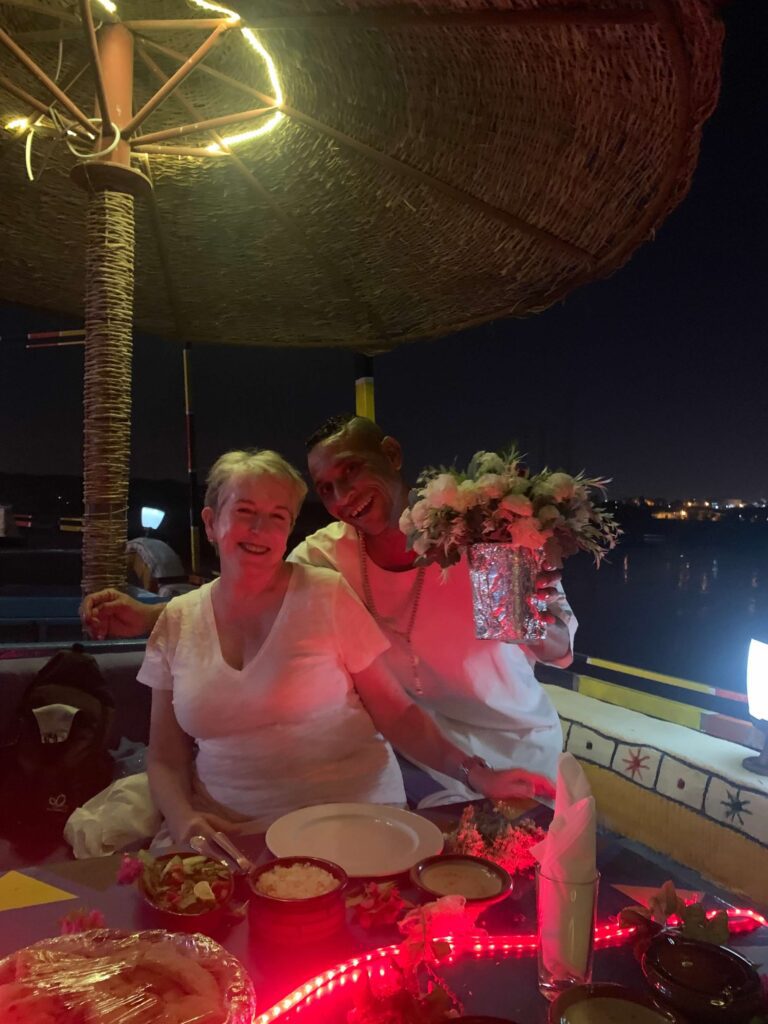
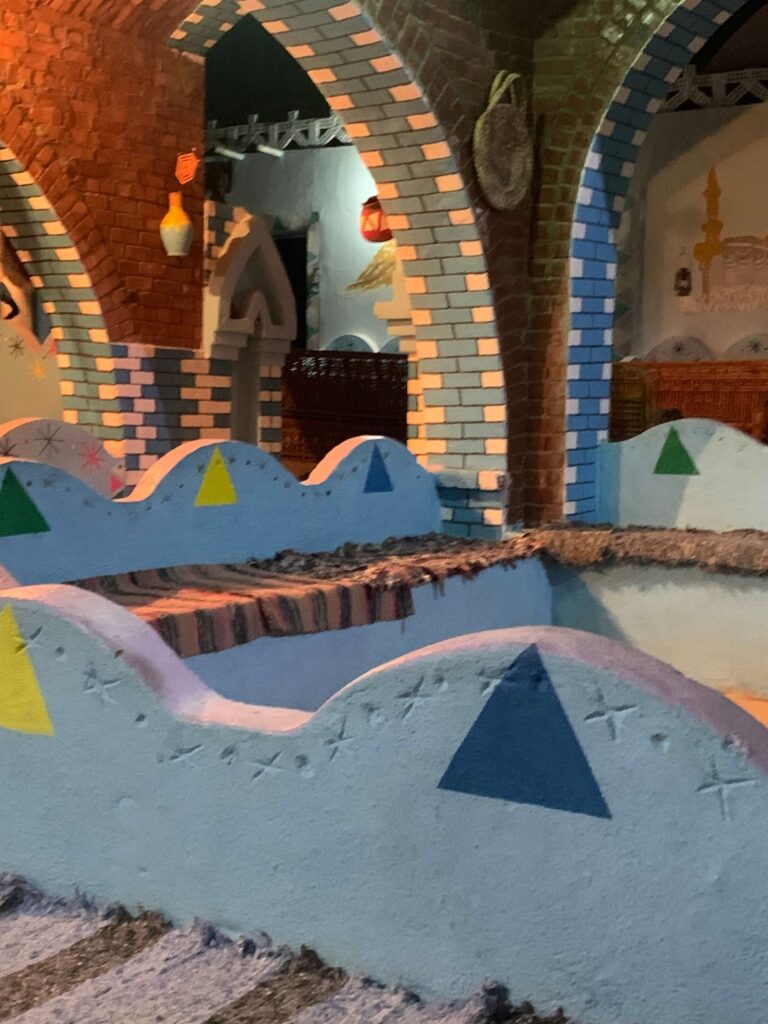

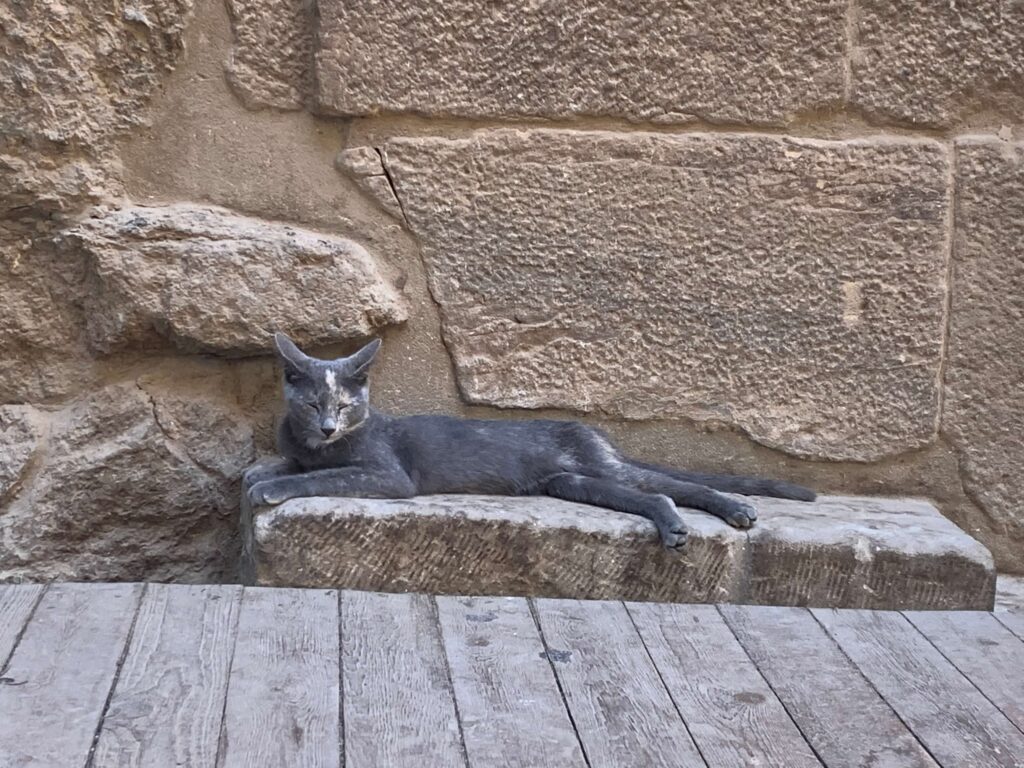

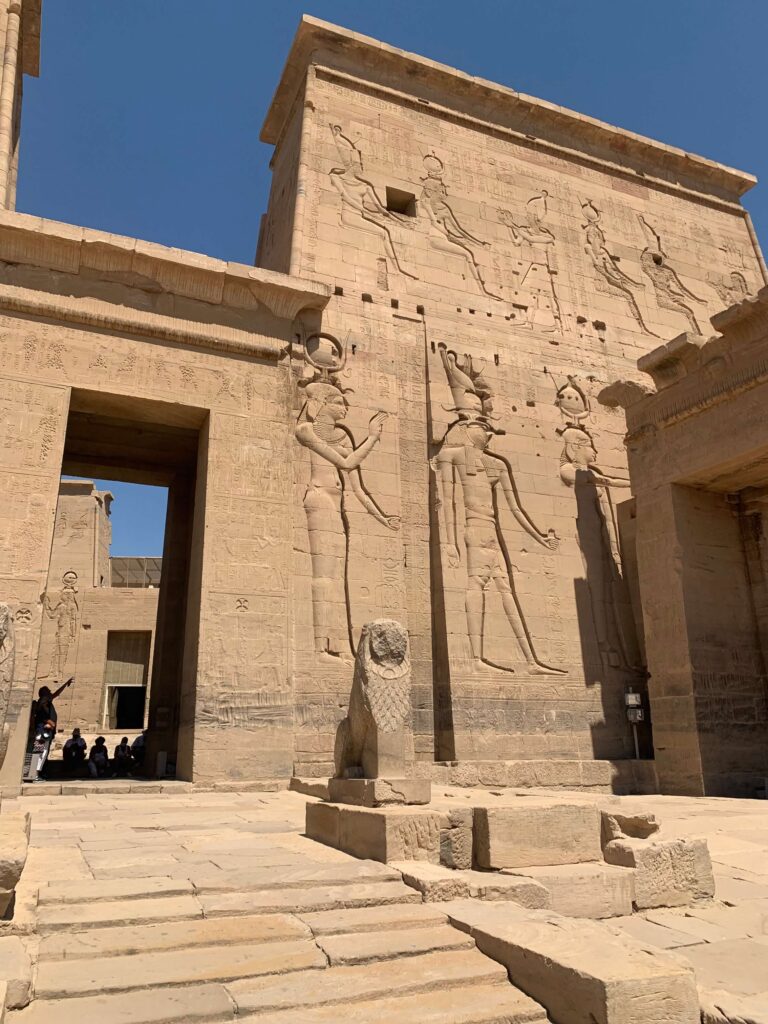

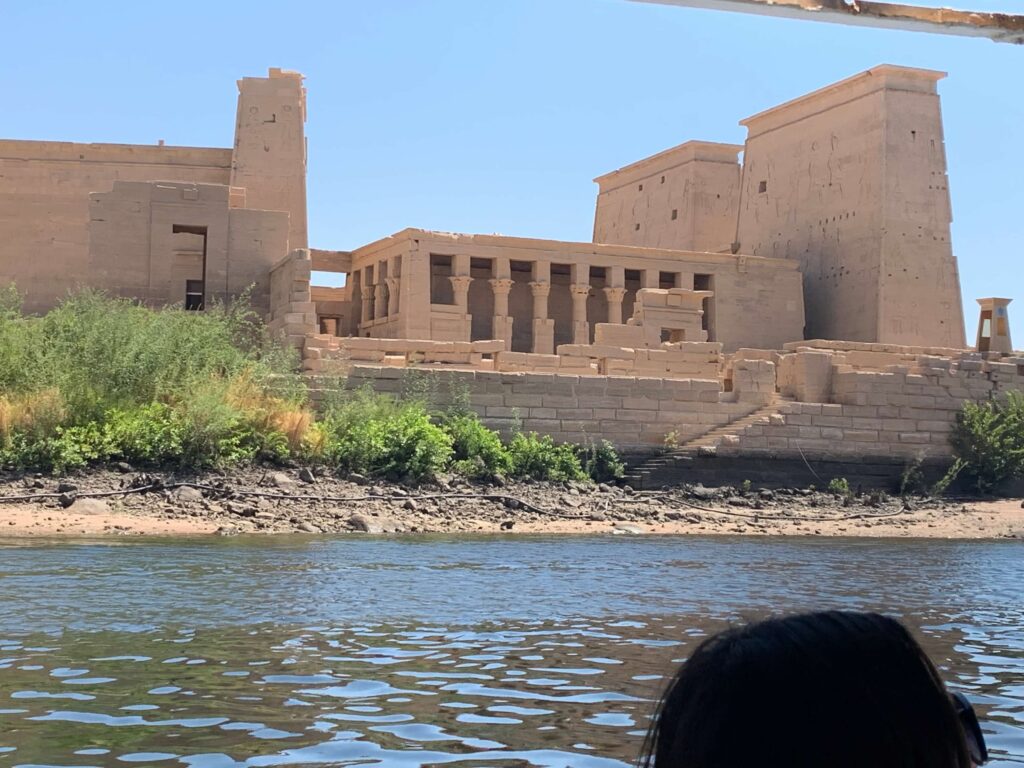

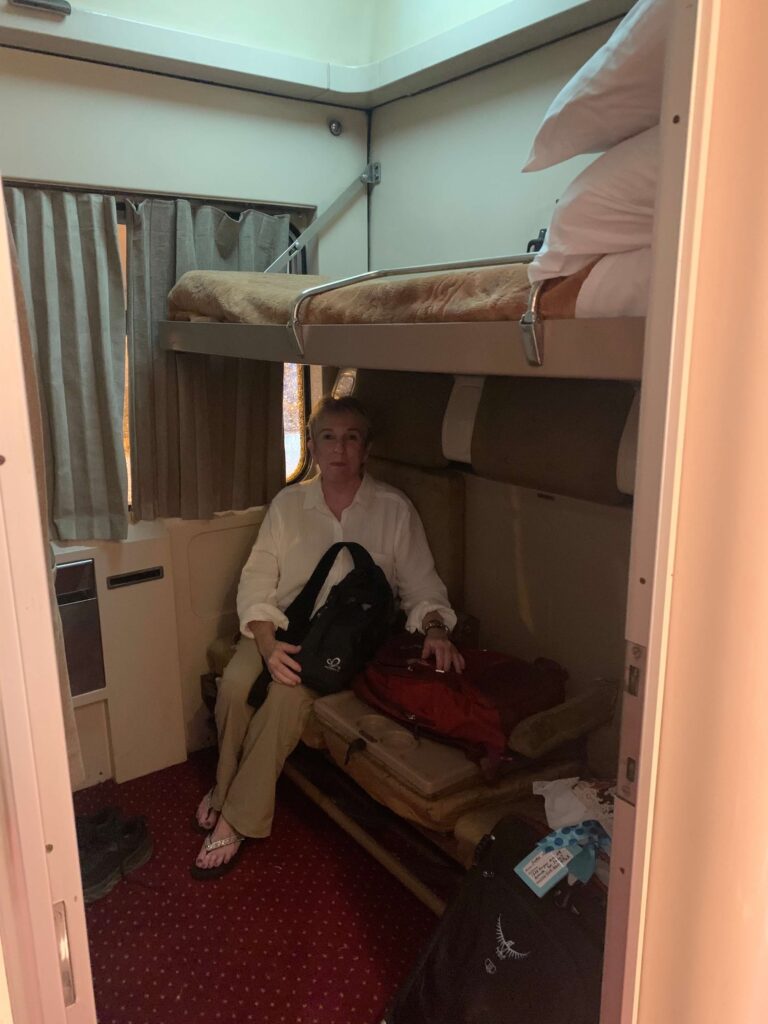

Abu Simbel
We were up at 4:30 am to try and catch the sunrise over Abu Simbel, but the sun had other plans and was up before we made it to the temple. The drive was about 4 hours.
Abu Simbel was a highlight of our time in Egypt. Today, Abu Simbel sits on the banks of Lake Nasser, close to the Sudanese border. Lake Nasser is one of the largest manmade reservoirs in the world, created as a result of the Aswan High Dam.
Abu Simbel consists of two massive temples which were carved out of a mountainside during the reign of Rameses II. In the 1960’s, they were dissembled and MOVED to another location on the shores of the Lake to protect them from floods.
Rameses II, aka Rameses the Great, has more statues and temples all over Egypt than anyone else. He is probably the most celebrated pharaoh of all time, and he was also a warrior. The larger temple at Abu Simbel has a massive doorway flanked by four statues of Rameses II. Inside of this temple, among other things, are four statues in a row: Rameses II (Pharaoh-god), the gods Amun, Ra, and Ptah. Amun created the universe, Ra is the god of sun and light, and Ptah is the god of craftsman and associated with the underworld. On February and October 22, the sun shines on Rameses, Amun, and Ra but not Ptah.
The second temple was built for his wife and great love, Nefertari, and the sky goddess Hathor, symbolic mother of the Pharaohs. Aboudi affectionately referred to Hathor as the “Goddess of the Holy Cow,” because she is often associated with images of cows. Cows are revered in many cultures and often symbolize motherhood and nourishment.
Rameses had the statues of Nefertari and Hathor built the same size as the statues of him, which speaks to how much he honored and respected his wife.
As an aside, the humble leader (haha) Rameses II is thought to have had 30 wives, 106 daughters, and 92 sons. He must have been a busy dude! Warring, pharoahing, and baby making!
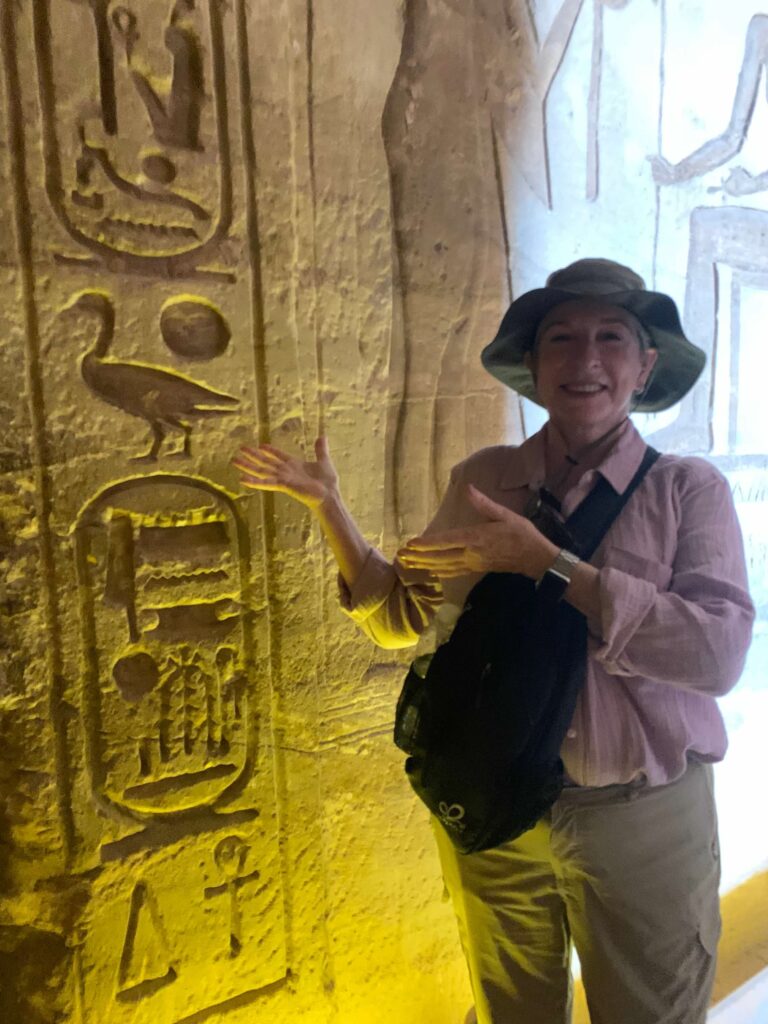



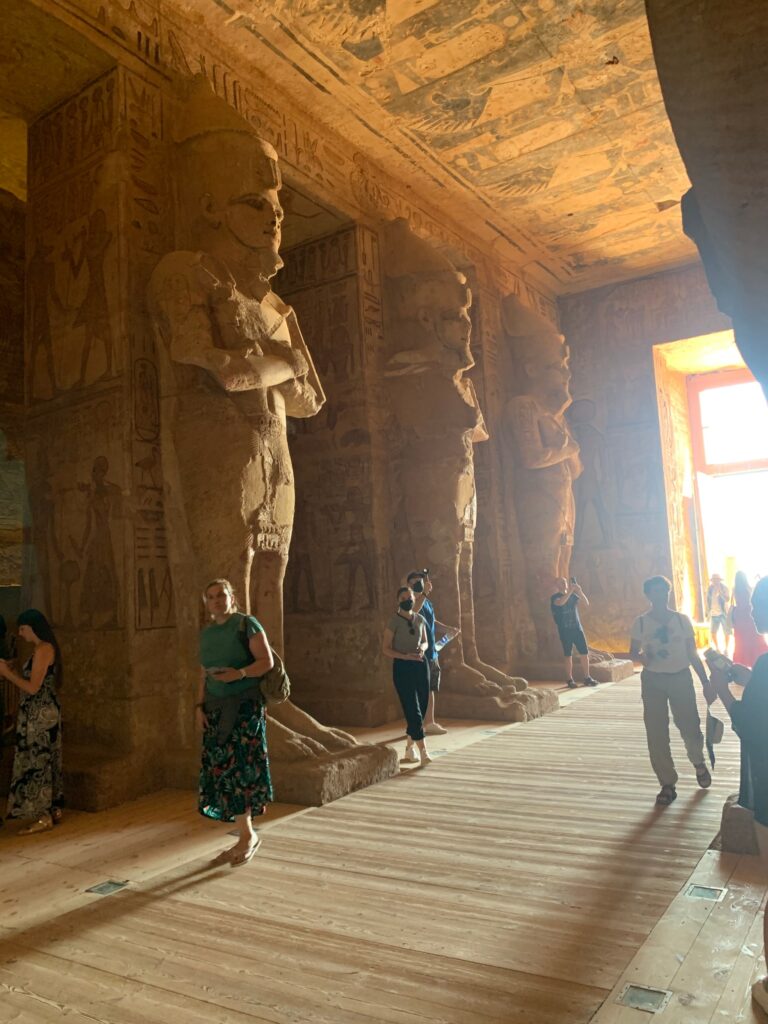

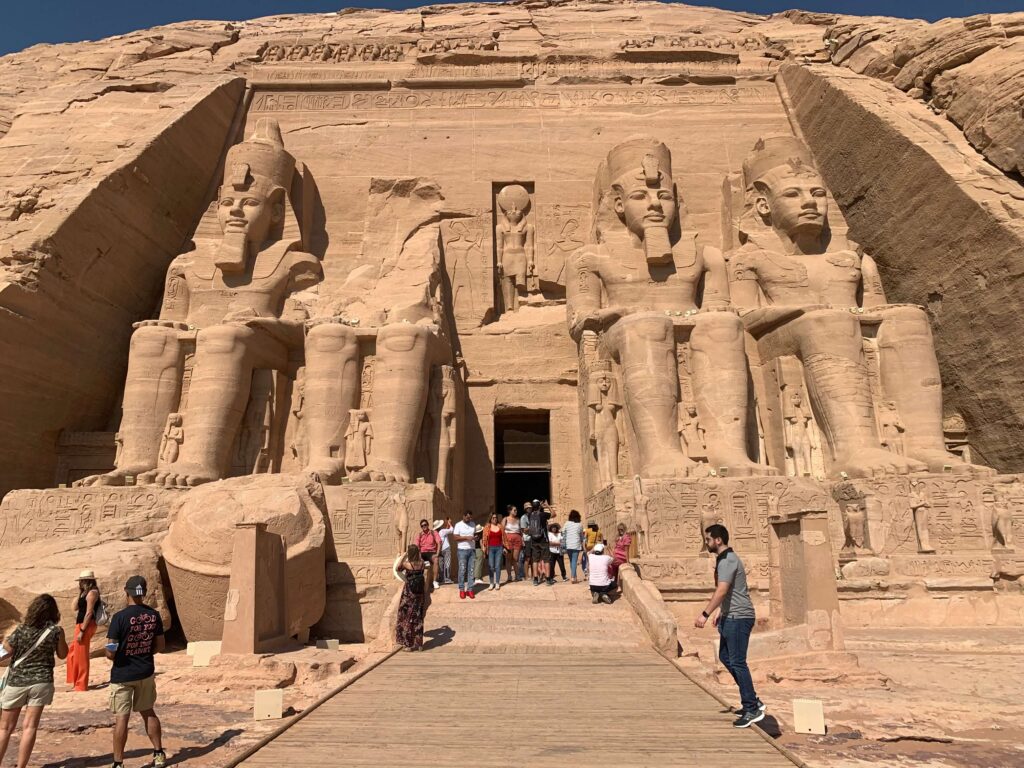

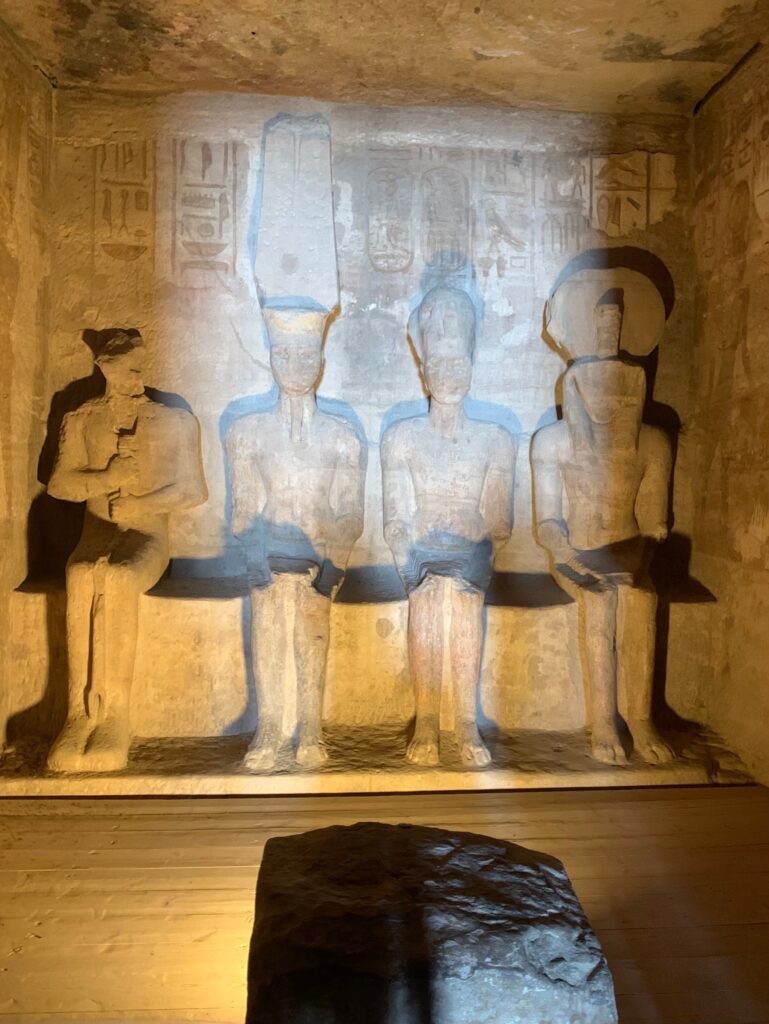

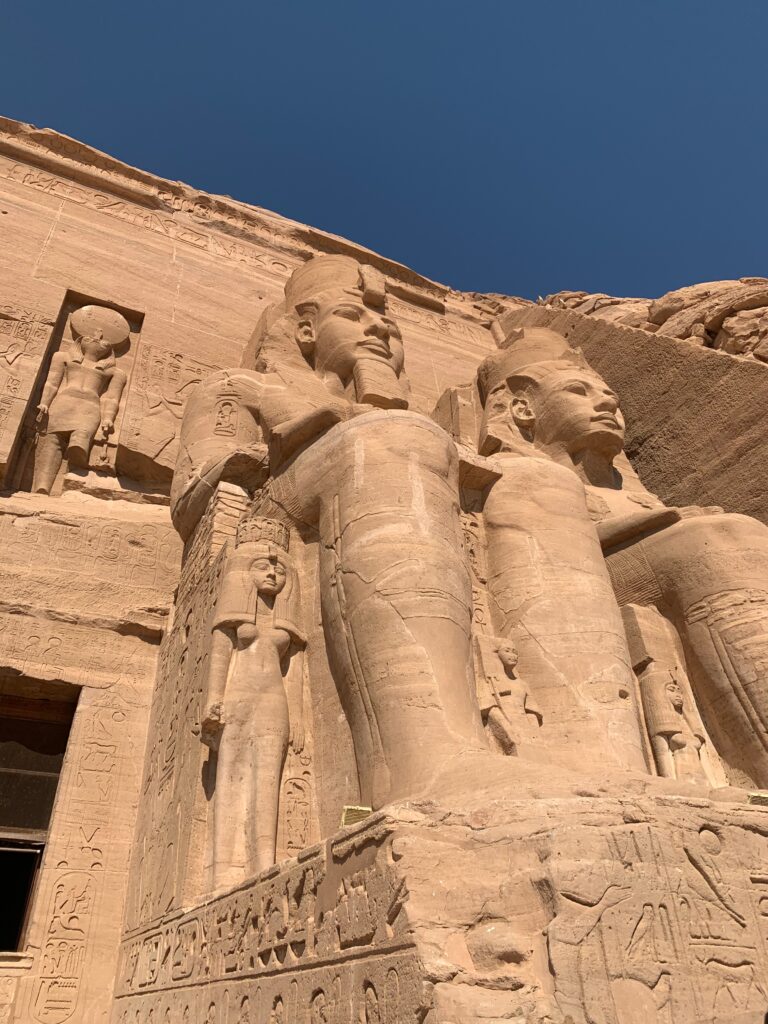

Don’t miss this one! The sheer scale of the statues is humbling and mind boggling!
And Another Boat Ride
Next Stop: Luxor! We took an overnight Nile River cruise onboard a felucca from Aswan to Luxor. Feluccas are traditional Egyptian sailboats, with open decks covered in colorful cushions and pillows and shaded by canvas. The bottom deck was covered in what amounted to a huge mattress. We were greeted by a Nubian crew who gave us platters of fruit to tide us over until lunch. These were some of the best, sweetest, juiciest mangoes I’d ever had!
We had lunch on the top deck, lounging on cushions. The star of the show was a beef and eggplant moussaka (sort of like lasagna with veg instead of pasta) which was divine!
The tour had advertised swimming in the Nile as part of the boat ride, and we were really looking forward to it. We really wanted to just jump off the boat in the deep part, but for some reason we were not allowed to do this. Crocs?? I don’t know… instead, we pulled up to the shore and waded into the water. We were not in there for long, because the water was nice and clear and allowed us to easily see all the donkey turds floating in the water…none of us wanted to submerge our bodies in that! So… “swim in the Nile,” check! Although we really just waded and I couldn’t get out of the mule toilet quick enough. Not to mention it was cold and the water icy!
The scenery was beautiful, watching the sun set over the mausoleums from the top deck. The water was punctuated by cataracts, shallow areas with rocks which break the water’s surface and cause areas of white water.
Dinner was nothing to write home about, but we had mint tea and good conversation until the late hour of 7:00 pm, when we moored up to a Nubian Village for the night. We all slept on the one mattress on the bottom deck, surrounded by mosquito netting. We tried to sleep to the sounds of dogs barking, people talking, and music playing.
If you get a chance to spend the night on a felucca, do it! This was a really. nice experience.
Edfu Temple
We still had quite a drive to get to Luxor. We stopped at Edfu Temple en route. This temple was dedicated to Horus, the falcon-headed god who was the son of Isis and Osiris. We timed this one just right and had the place to ourselves!
Interesting thing about Edfu- Nile River cruisers often stop here, and they are required to take horse and buggies to Edfu Temple to support the locals.
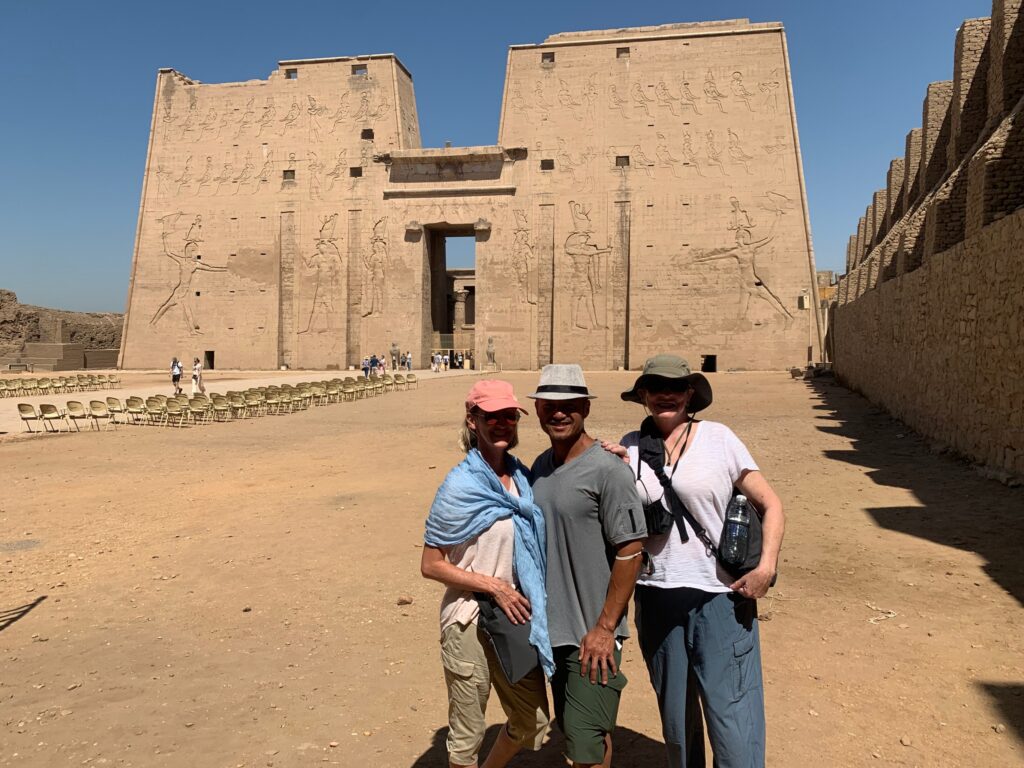



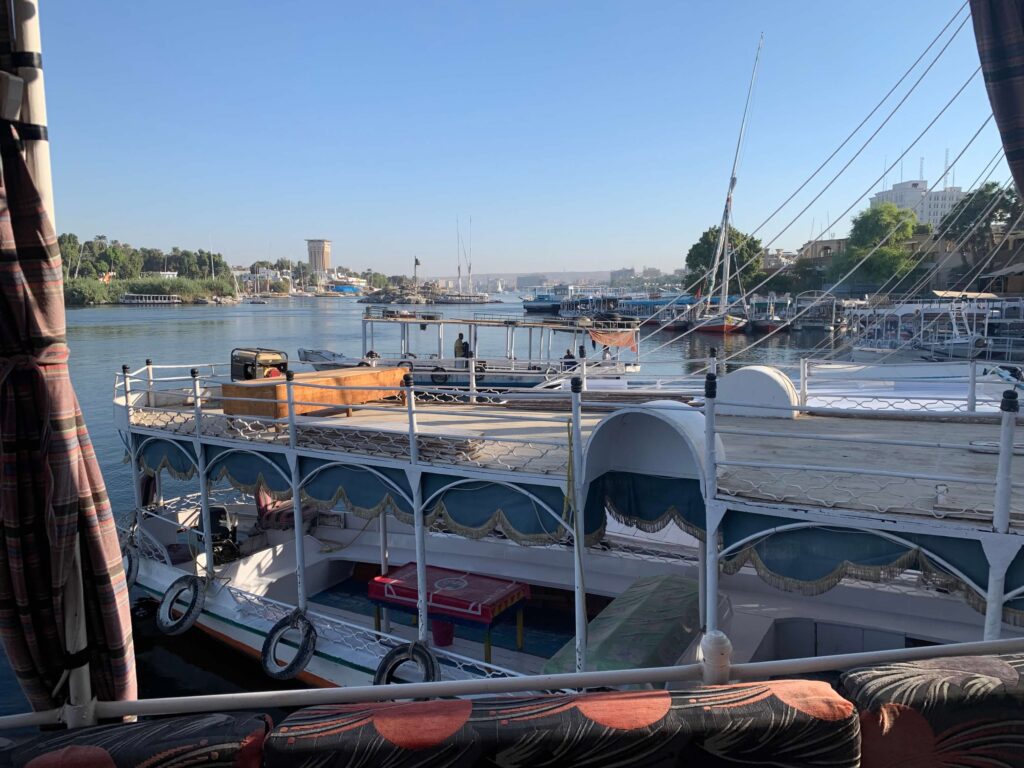

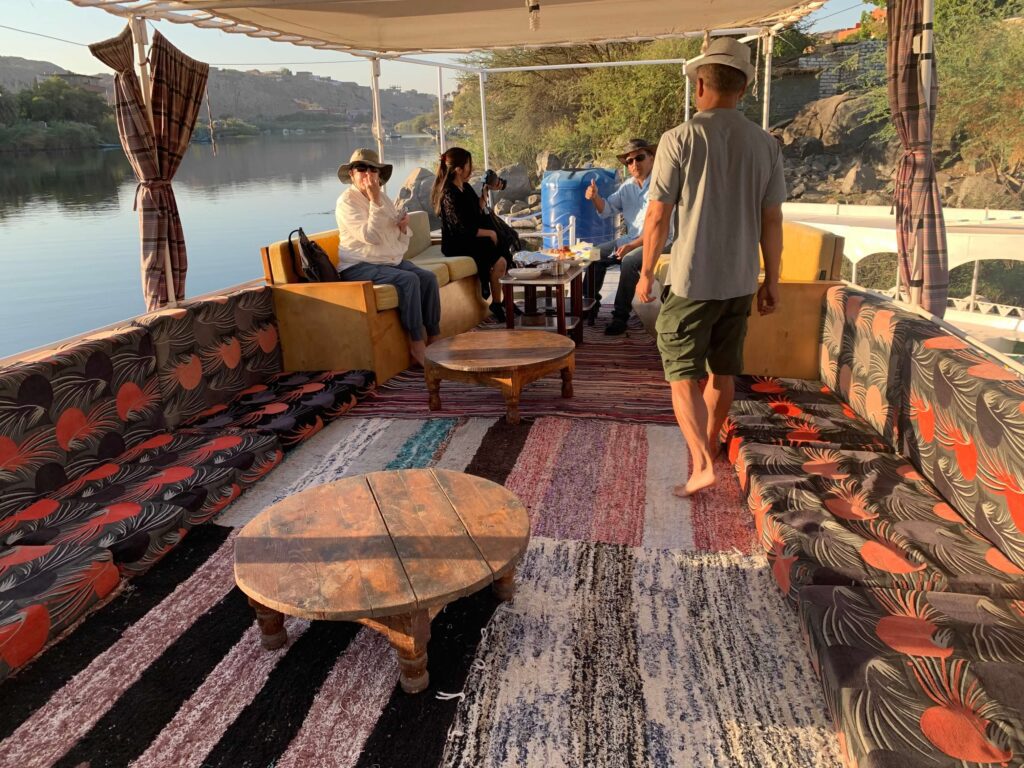



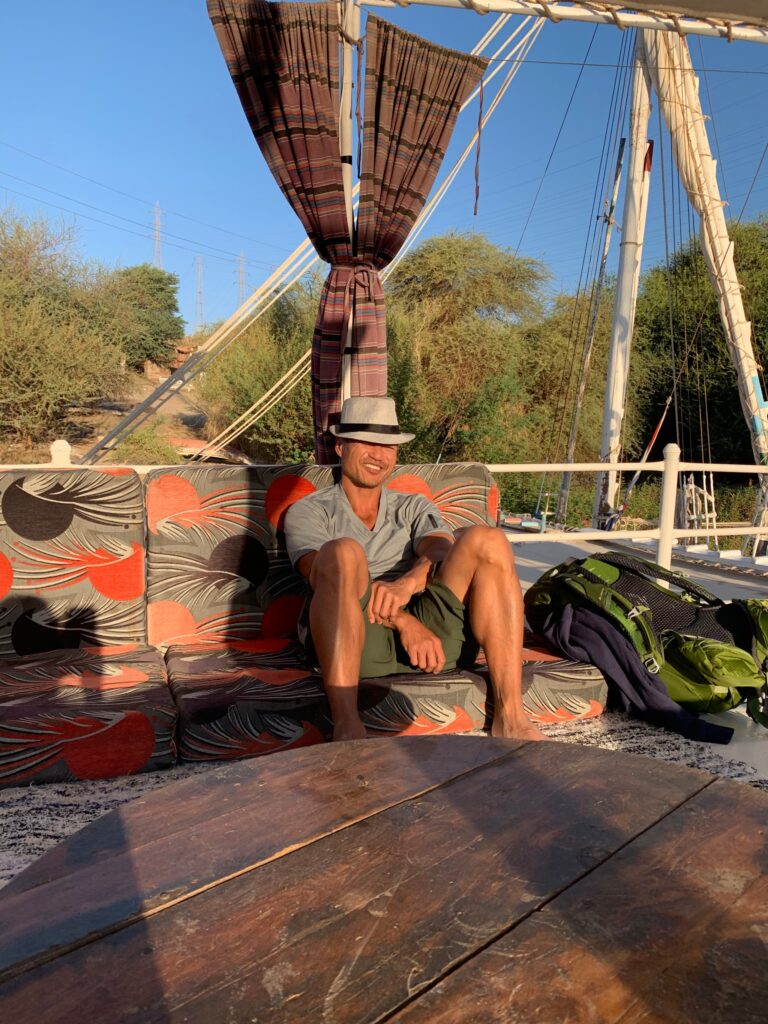

Until Next Time…
That concludes the second part of our trip to Egypt. This trip has been filled with education and novel experiences, shared with friends new and old!
Come back next time to read about our time in the amazing city of Luxor, where we visit Luxor Temple, Karnak Temple, the Valley of the Kings, and take a hot air balloon ride! We channel our inner Indiana Jones as we descend into ancient pyramids deep in the Western Desert.
